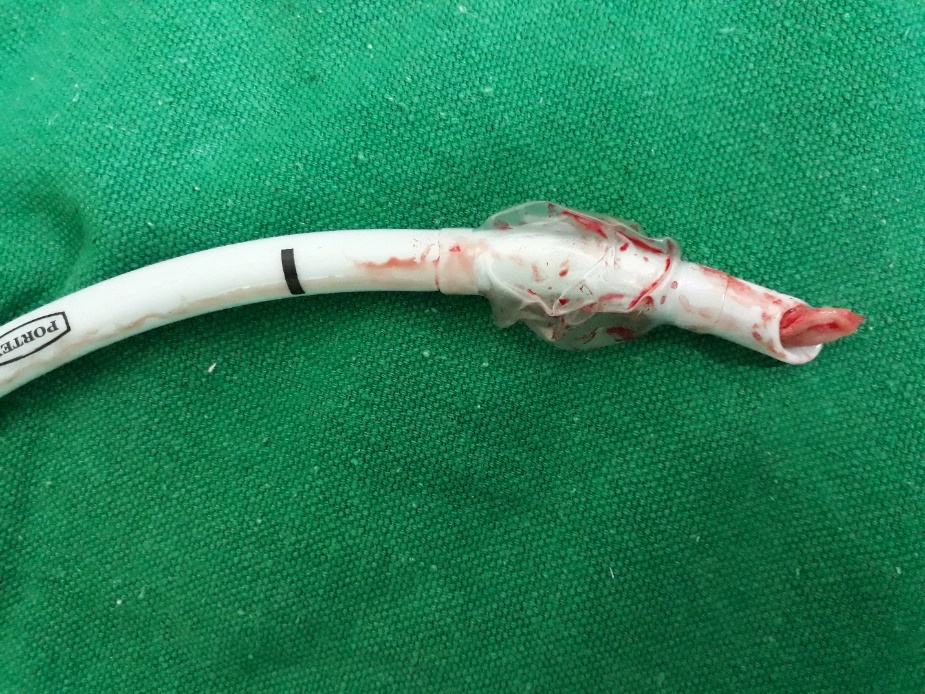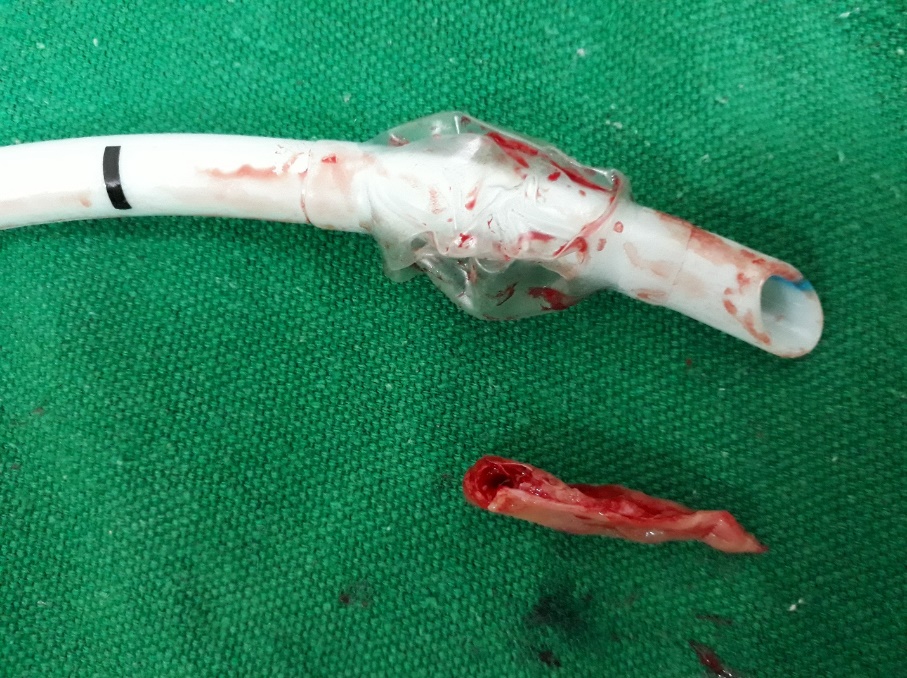Pravin Ubale1, Swati Chhatrapati2, Shweta Jaju3, Supriya Pabalkar4, Ashwinkumar Karre4
1Associate Professor, 2Professor. 3Assistant Professor, 4Registrar
Dept of Anesthesiology, TNMC & BYL Nair Charitable Hospital, Bombay Central
Mumbai- 400008 Maharashtra, (India)
Correspondence: Dr Pravin Ubale, Anand Bhavan, B Building, Flat No.16, 4th floor, TNMC & BYL Nair Charitable Hospital, Bombay Central, Mumbai – 400008 Maharashtra, (India); Tel: 9322211472; E-mail: drpravinubale@gmail.com
ABSTRACT
Nasotracheal intubation is commonly performed for airway management during maxillofacial surgery. The semi-soft PVC tubes are known to cause upper airway injuries, including bleeding, avulsion of turbinates or nasal polyps. However, complete obstruction of the tube is a rare phenomenon. We report a case of an 18 years old male patient posted for fixation of fractured mandible in whom the inferior turbinate was avulsed while performing nasotracheal intubation. It occluded the endotracheal tube, resulting in ventilation failure which was successfully managed. We stress that if one encounters ventilation difficulty after nasal intubation, possibility of turbinate tissue occluding ETT lumen should be kept in mind and forceful ventilation must be avoided. “When in doubt, take it out.”
Keywords: Inferior turbinectomy; Ventilation failure; Nasotracheal intubation; Complication; Foreign Bodies/etiology; Humans; Trachea
Citation: Ubale P, Chhatrapati S, Jaju S, Pabalkar S, Karre A. Accidental inferior turbinectomy: a complication of nasotracheal intubation. Anaesth Pain & Intensive Care 2018;22(2):234-237
Received – 13 Mar 2018, Reviewed – 7 Apr 2018, Accepted 7 Apr 2018
INTRODUCTION
Nasotracheal intubation is commonly performed during maxillofacial and oral surgeries as it has the advantage of giving easy accessibility and an optimal working environment in the oral cavity for the surgeon. Although nasotracheal intubation is generally safe, it still poses risk of complications, the most common being nasopharyngeal bleeding with an incidence of 18–66%.1
Various other complications reported in the literature include sinusitis due to obstruction to sinus drainage, transient bacteremia, endotracheal tube (ETT) obstruction, dislodgement of adenoids from mechanical trauma, turbinate avulsion, retropharyngeal perforation, mucosal laceration, cribriform plate fracture, olfactory nerve injury and perforation of pyriform fossa.2-5
The nasal turbinates contribute to the nasal function of humidification, warming, and filtration of inspired air.6 The avulsion of turbinate during nasotracheal intubation is not very common. We report successful management of the avulsed inferior turbinate that caused ETT occlusion resulting in ventilatory failure.
CASE REPORT
An 18 years old male patient was referred to our institution for fixation of fracture of right ramus of the mandible. Patient had history of road traffic accident a month back with loss of consciousness and one episode of convulsions. Patient was intubated and required ventilatory support for three days He was extubated on the fourth day in private hospital. Patient was started on tab phenytoin sodium 200 mg TDS. CT scan revealed linear un-displaced fracture of right frontal bone extending up to the roof and right ethmoid sinus, anterior clinoid process and lateral pterygoid plate, fracture of medial and lateral wall of the right orbit, and fracture of right ramus of the mandible. Visualized intracranial structures appeared normal.
On general examination, his pulse rate was 88/min, and BP, 120/80 mmHg. His cardiovascular and respiratory system were within normal limits. Upper airway examination revealed Mallampatti score of grade I. All biochemical investigations were within normal limits. Both nostrils were examined and the right nostril was found to be roomier with good blast of air.
On the day of surgery, written informed consent was obtained and patient was transferred to operation theatre where standard monitors were placed. 30 minutes prior to surgery, xylometazoline nasal drops were put in both nostrils. Patient was premedicated with Inj. glycopyrrolate 0.004 mg/kg, Inj. fentanyl 2 µg/kg, Inj. midazolam 0.03mg/kg, and Inj. Ondansetron 8mg. Anesthesia was induced with graded dose of Thiopentone sodium 3-5 mg/kg till loss of eyelash reflex. Inj. vecuronium 0.1 mg/kg was administered after confirmation of mask ventilation. After 3 min of positive pressure ventilation, a size 7.5 RAE cuffed ETT (Ivory North Pole) was lubricated and inserted through right nostril. With minimal resistance, the tube was advanced into the oropharynx. Direct laryngoscopy was performed to negotiate the tube through vocal cords. Minimal bleeding from the nasal cavity was noted. After thorough suction, the tube was negotiated through the vocal cords with the help of Magill’s forceps under vision. Cuff was inflated and breathing circuit was connected. On manual ventilation, there was resistance to ventilate. End tidal CO2 (ETCO2) tracing was absent with no chest movements on ventilation. Chest auscultation revealed complete absence of air entry bilaterally with no sound on abdominal area too. ETT position was rechecked by direct laryngoscopy and was found to be in correct position. Bronchospasm was suspected and 2 mL of inj. etofylline and theophylline, inj. hydrocortisone 100 mg, inj. dexamethasone 8 mg were given intravenously and two puffs of budesonide spray were given through tracheal tube. There was no response to the above-mentioned drugs, the bag was still tight and patient was not getting ventilated. Hence decision was taken to remove the ETT. On removal of the ETT, we found a soft tissue mass totally occluding the lumen of ETT which explained complete absence of air entry bilaterally (Figure 1 & 2).

Figure 1: Inferior turbinate stuck at the tip of the ETT

Figure 2: Excised inferior turbinate
The oxygen saturation remained at 98%. Patient was mask-ventilated with 100% oxygen for 3 min. ENT surgeon was called for assessment. Nasal endoscopy was done by ENT surgeon and he diagnosed the tissue occluding the ETT as inferior turbinate. Active bleeding was not seen. The avulsed turbinate was firmly stuck in the orifice at the end of the tube. As it was an oral surgery, it was decided to do nasal intubation through left nostril. Patient was successfully intubated with 7.5 number RAE cuffed ETT (Ivory North Pole) through left nostril, which was confirmed with auscultation and capnography. Throat packing was done. At the end of the surgery, it was confirmed that there was no active bleeding from the nasal cavity. The patient was extubated after complete reversal of neuromuscular blocking drugs and was shifted to the PACU for postoperative monitoring.
DISCUSSION
During nasotracheal intubation, trauma to inferior turbinate is more common than middle turbinate because of its anatomic location and closer proximity to the endotracheal tube during nasal intubation.7 However preexisting intranasal abnormalities, such as an enlarged inferior turbinate or a septal spur, by redirecting the nasotracheal tube higher into the nasal cavity increase the risk of middle turbinate trauma.8 Deviated nasal septum and nasal spurs are considered to be risk factors for trauma during intubation. With the left-sided bevel of the tube and the sharper tip on the right, the turbinates are more at risk of damage in the right nostril whilst the septum is more at risk in the left nostril.9 Other causes of ETT obstruction during nasotracheal intubation are blood clots and foreign bodies. There is also a case report of nasotracheal tube obstruction by a central incisor.10
Moore has suggested a technique for nasotracheal intubation that prevents damage to the turbinates. The nose should be adequately decongested prior to intubation, and lubrication should be applied to the tube. Intubation is performed with cephalad traction on the tube and with the bevel directed laterally so that its leading edge is pointed away from the turbinates. As soon as the tip of the tube is visualized in the oropharynx, the part of the tube outside the nostril is returned to its normal curvature and advanced toward the larynx.11
Submental and retromolar intubation are another option for fracture mandible, but in our case we proceed with nasal intubation. Experienced Anesthesiologists develop judgment to apply accurate threshold pressure to advance the tube into the trachea. However, if more than threshold pressure is required, it is advisable to do nasal intubation through another nostril.
It is prudent to check patency of the tube after passing it through the nostrils, but before pushing it through the glottis. If one encounters any degree of resistance to air flow, possibility of turbinate or mucosal tissue occluding the lumen of ETT should be kept in mind and forceful ventilation must be avoided. The best strategy is to follow the rule, “when in doubt, take it out”. The tube can be removed and then intubation tried through the other nostril. If care is not taken, the tissue can be pushed into tracheobronchial tree and cause serious respiratory complications.
In our case, forceful ventilation could have dislodged the avulsed inferior turbinate in the trachea or bronchus. The exact cause for avulsion in our case is not known but excessive pressure while introducing the nasotracheal tube could be a reason.
Such complications can be prevented by selecting correct nostril and adequate preparation by local application of vasoconstrictive drugs. Lubrication and dilation of the nostril prior to intubation, softening the tube, using the smallest compatible tube and avoiding excessive pressure during intubation, can be helpful. A soft nasopharyngeal airway can be used as a pathfinder.
CONCLUSION
Accidental inferior turbinectomy is a rare and very dangerous complication during nasotracheal intubation. It is prudent to check patency of the tube after passing it through the nostrils, but before pushing it through the glottis. If one encounters ventilatory difficulty, possibility of turbinate tissue occluding the lumen of ETT should be kept in mind and forceful ventilation must be avoided. When in doubt, take it out.
Authors’ Contribution:
PU: Conduction of study work
SC: Concept
SJ: Manuscript Editing
SP & AK: Searching literature + references
REFERENCES
- PiephoA. Thierbach C. Werner. Nasotracheal intubation: look before you leap. Br. J Anaesth 2005; 94:859-60
[PubMed] [Free full text] DOI: 10.1093/bja/aei146 - Gravenstein N: Manual of Complications during Anesthesia, 1st Edition. New York, Lippincott, 1991, pp 620-3
- Kronberg FG, Goodwin WJ: Sinusitis in intensive care unit patients. Laryngoscope 1985; 95:936-8[PubMed]
- Depoix JP, Malbezin S, Videcoq M, Hazebroucq J, Barbier-Bohm G, Gauzit R, et al. Oral intubation v. nasal intubation in adult cardiac surgery. Br J Anaesth 1987; 59:167-9[PubMed] [Free full text]
- Lera, S., Machan, M.and Derefaka, G.A SaferTechnique for Nasal Intubation. A Literature. Review. Open Journal of Anesthesiology, 2017;7:275-285.[Free full text] DOI: 10.4236/ojanes.2017.78028
- Anand VK, Panje WR: Practical Endoscopic Surgery, 1st Edition. New York, McGraw-Hill, 1993, pp 16-25, 171-2
- Stankiewcz JA: Advanced Endoscopic Sinus Surgery, 1st Edition. New York, Mosby, 1995, pp 2
- Wigand ME. Steiner W, Jaumann MP. Endoscopic surgery of the paranasal sinuses and anterior skull base. New York: Thieme; 1990:25-6. [Free full text]
- Coe TR. Human M. The peri-operative complications of nasal intubation: a comparison of nostril side. Anaesthesia May 2001;56: 447–484[PubMed] [Free full text] https://doi.org/10.1046/j.1365-2044.2001.01524.x
- Kenney JN, Laskin DM. Nasotracheal tube obstruction from a central incisor. Repot of a case. Oral Surg Oral Med Oral Pathol 1989;67(3):266-7[PubMed]
- Moore DC. Bloodless turbinectomy following blind nasal intubation: Faulty technique? Anesthesiology 1990;73:1057. [PubMed] [Free full text]

